














Product details
4 channels, 20MHz, 20MS/s, 10Kbyte memory per channel, cursors, Analog, Monchrome Display, 2mV to 10V vertical sensitivity, 40ns to 10ms sweep time
Key Features & Options
20 MS/s Sample Rate
20 MHz Bandwidth
4 Input Channels
50 ns Glitch Capture
Pre-Trigger and Trigger Delay
Measurements and Analysis
Auto-setup
X-Y Display
Internal Thermal Recorder Output
Gould's 1600 Series digital storage oscilloscope family has become one of the most successful electronic test instruments ever, with tens of thousands of products sold worldwide.
The reasons for their success are clear. They were the first 4-channel instruments which combined real-time/digital-storage oscilloscope capability, ease of use, versatility and long memory with a host of other features such as differential inputs (enabling 1600's to meet international safety standards), integral plotter and glitch detection - all at an affordable price.
The 1600 Series soon became an industry standard for users in a wide range of application sectors including automotive, industrial and medical. Since its launch, the range has been extended to include the world's first digital recording oscilloscope (DRO), with a combination of oscilloscope and recorder features for even greater versatility.
Users range from suppliers of respiratory equipment for health care, who use 1604 DROs to monitor pressure waveforms during breathing, to hydroelectric power generators using the 1604 DRO to monitor power lines.
One manufacturer of large industrial presses, for example, uses the 1604 as part of a high-speed data-acquisition system as well as a 'quick look' device for measuring strain, vibration, pressure and motion. Elsewhere, a supplier of custom- designed control systems needed portability and hard copy output for measuring and recording high-speed signals in remote locations.
In the medical field, the physiology and biophysics department of a major university uses the 1604's slow-sweep and long memory for detecting neural signals.
The diverse nature of 1600 applications is emphasized by a supplier of paper products who needed four channels to monitor and record DC variable-speed drives using medium-voltage control signals. The 1604 DRO's resolution plus its continuous paper output fitted the application perfectly, as did the ability to use the instrument in other problem areas. A related application was a company looking for glitches on power drives, who appreciated the instrument's versatility in being able to be used as an analog or storage scope depending on the application.
In the more traditional electronics sector is a manufacturer of electronic tubes for CAT scanners, mammography equipment, radios and televisions, radar and high-voltage equipment. In this application, the color plotter was used to provide instant documentation from testing on the shop floor.
In ten years, the 1600 Series has come a long way, and judging by the level of interest in this versatile range, it will continue to provide measurement solutions to markets worldwide.
Updated 6 Jan 1997